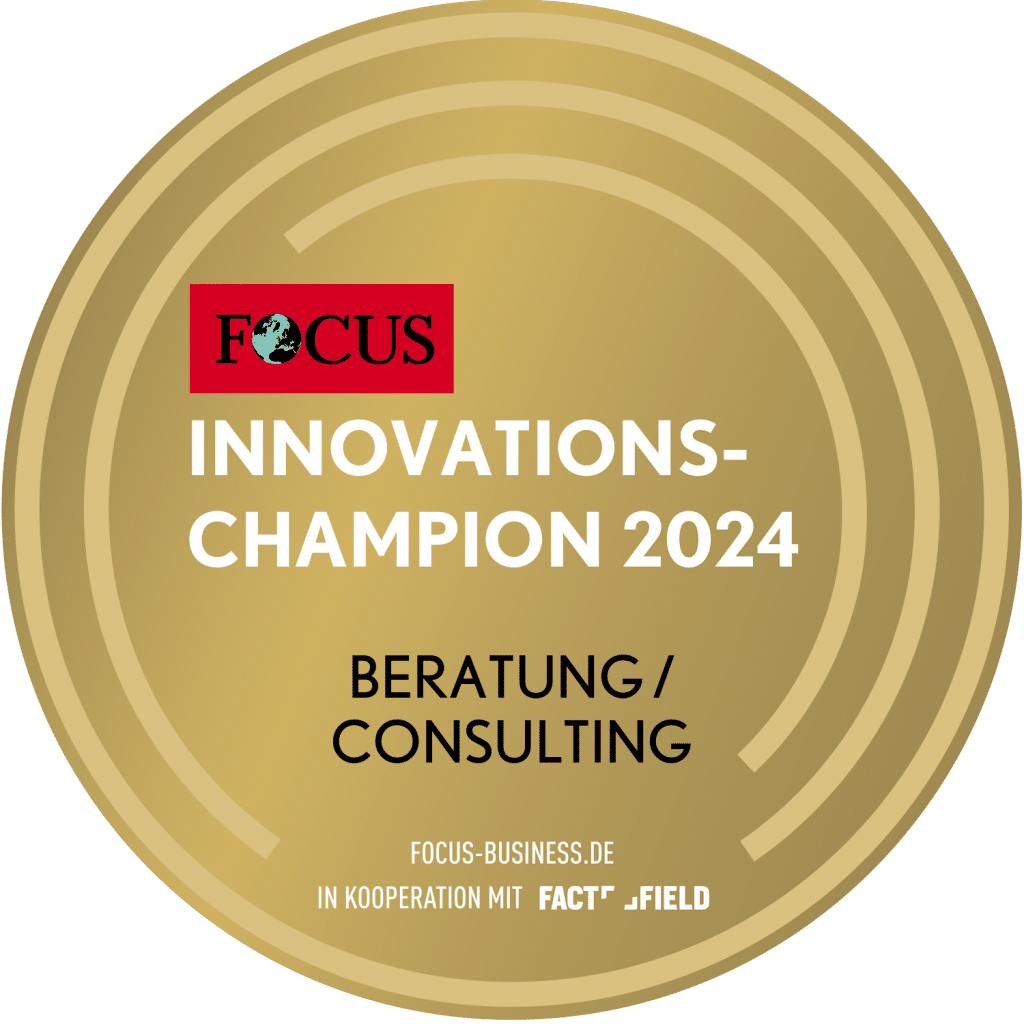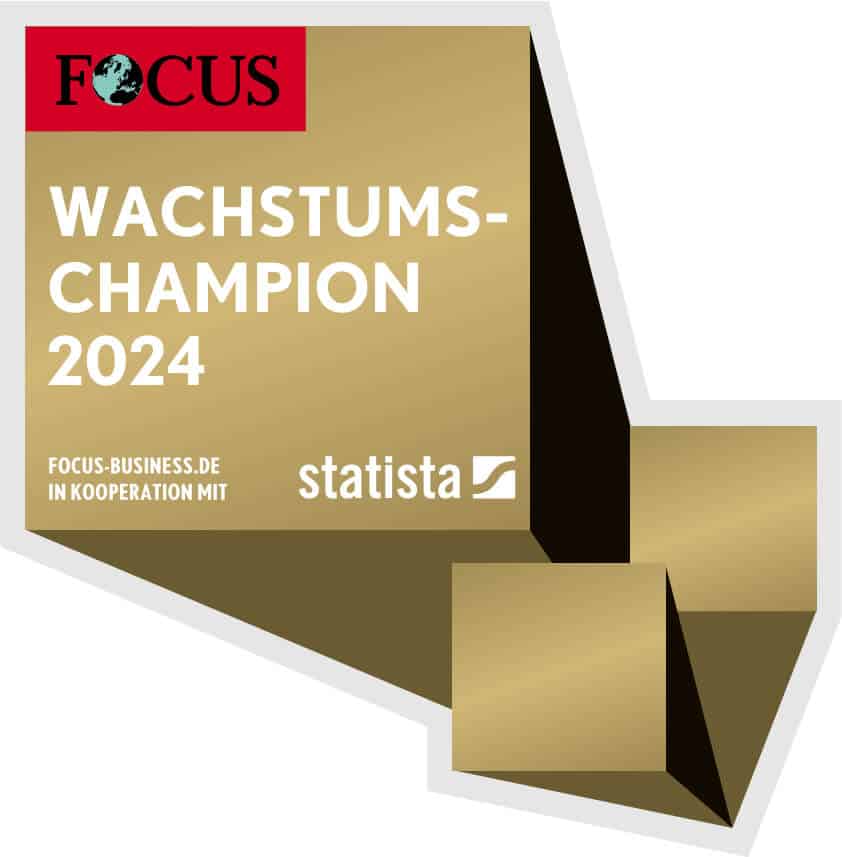According to systems theory, there are two successful strategies for organisms or systems to assert themselves in their environment. It is either to be the first or the best. The current hype surrounding the topic of agile focuses exclusively on the first strategy. The second alternative in the "fight for survival" is often presented as outdated in this context. The following article presents a decision-making model in which both strategies are equally valid options.
Only agile - or what?
There is no doubt that digitalization will pose enormous challenges for society and the economy in particular. Old business models will be replaced by new ones, boundaries between the partners involved will be redefined and the interface to the customer will be redesigned. And all this under completely new framework conditions. The term VUCA summarizes the new situation that companies will have to cope with in the future as follows: It is
- volatile (Volatility)
- Uncertainty
- complex (Complexity)
- ambiguous (ambiguity).
In order to master these challenges while keeping pace with the speed and radical nature of innovation, companies need to become faster and more flexible. Under this digital pressure to act, more and more companies are looking for new concepts.
One approach is prominent here: agile methods have now arrived in all sectors. The positive reports are overwhelming and praise agility as having no alternative. The slogan in many studies and publications is: the more agile the company, the greater the success. It is not only faster and more flexible, but also significantly better than traditional companies.
However, most of these often exaggerated observations overlook the fact that the traditional world has also been very successful to date. Many medium-sized companies have grown continuously in recent years. Germany has become the world export champion with the methods practiced there. The prevailing mode was dominated less by the agile approach and more by the operational excellence approach.
In this respect, it is worth taking a closer look and differentiating. Where does the agile approach have its strengths and where does the operational excellence approach?
Be the first or the best
The starting point for the following considerations are two system states A and B. State A corresponds to a predefined actual state, state B to a desired target state. The task is to convert state A into state B.

In practice, the tasks could look like this:
- a project task: Find a solution to a specific customer problem.
- A departmental assignment: Work on a specific task and go through certain processes.
- a transformation in the organization: redesign a specific business process.
The person responsible for such a task is primarily interested in the method of transfer. There are always different options as to how or by what means a goal can be achieved. The key question is which option is best suited for this.
An initial answer to this question can be found in general systems theory and systemic evolutionary theory:
In an energetically decaying world, all (energetic) systems are forced to reproduce themselves. All change takes place in the process. This also applies to the same extent to economic systems. If a system has to change its system state, this can happen in two ways, to put it simply. One can be the First or you can follow the Best be.
Being first means nothing other than being able to spread out in an 'ecological' niche without any opponents. An equivalent term for the same principle is to be the Most innovative to be. The recipe for success in order to survive the competition is - at least for a short time - to bypass it and find and occupy a new empty niche. Being the best, on the other hand, means winning the competition in your niche against all other competitors. An equivalent description of the principle is to be the Most efficient to be.
Our entire competition takes place between these two extremes, which can be understood as winning strategies.
The extremes: efficiency and innovation
These two winning strategies - "being the most efficient" or "being the most innovative" - can also be interpreted as two poles that characterize the nature of the concrete objective of economic activity. Above this concrete goal, of course, there is the fundamental compulsion to compete with all others. If the focus is on efficiency, it makes sense to align your actions to a large extent with this principle. Alternatively, you can follow the principle of innovation and do everything that promotes innovation. However, the two strategies are opposites and, in particular, have different prerequisites.
One Efficiency-oriented approach The success of a project depends on knowing the situation very well and having sufficient knowledge and, above all, experience (best practice) to be able to plan the necessary activities in detail and thus also measure them. Based on this knowledge, it is possible to make the right estimates and measurements and to continuously improve. The aim is to minimize errors and waste and to produce an equal or better product with a more favourable ratio of resource consumption to yield (disciplined problem solving).
The Innovation-oriented approach or simply being the first means breaking new ground. There is no best practice to follow. The methods used are therefore based on short iterative work cycles and constant comparison with the client or customer. This minimizes risks on the one hand and successively optimizes the result on the other. In order to create something new, the framework conditions are changed so that creativity can unfold. Not solving the problem is not seen as a failure, but as an equally important result and an essential part of a learning process (trial and error experimentation).
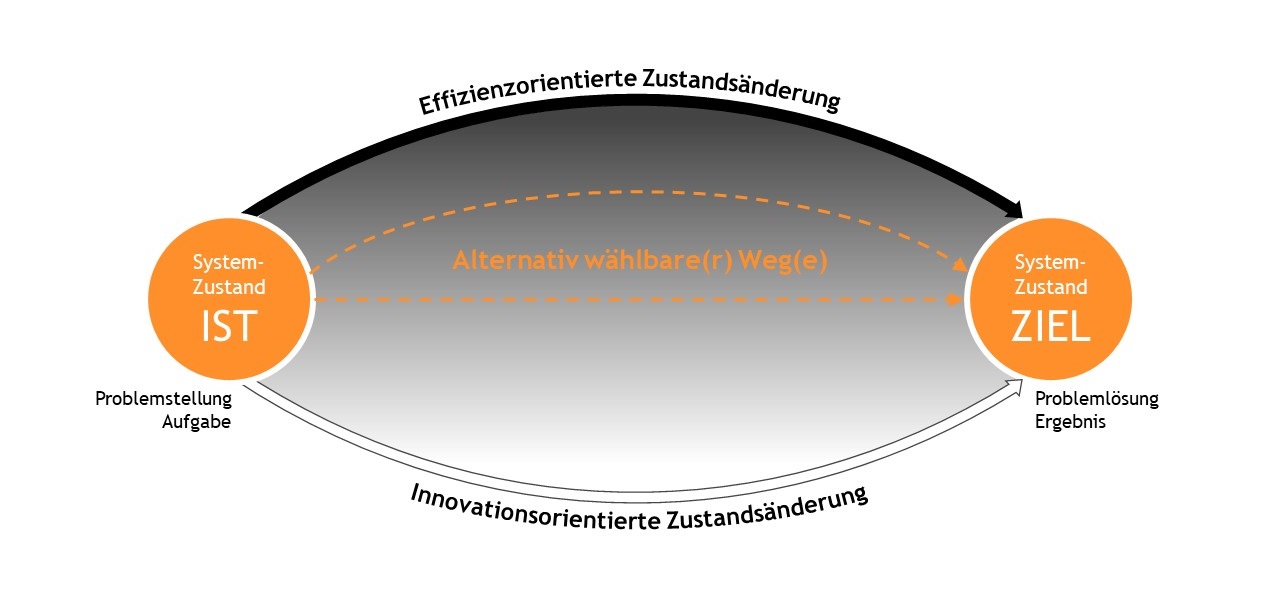
In Figure 2, this situation is illustrated by two graphs whose edges symbolize the extreme values of possible approaches. The upper graph represents a 100 percent efficiency-oriented approach. The lower graph corresponds to 100 percent innovation orientation. Normally, the specific solution chosen in practice lies in between. If you assign colors to the poles - in our proposal, 100 percent efficiency is assigned the color black and 100 percent innovation is assigned white - the world in between is gray. And it is precisely in this gray area that the actual solution lies in practice.
What makes the difference
Two models that are increasingly being used in practice for decision-making are the Cynefin model by Dave Snowden (Snowden & Bone 2007) and the Stacey matrix by Ralph D. Stacey. Both distinguish between the four problem situations "simple", "complicated", "complex" and "chaotic". The Cynefin model also assigns a schematized recommendation for action to each situation, which is described in more detail below.
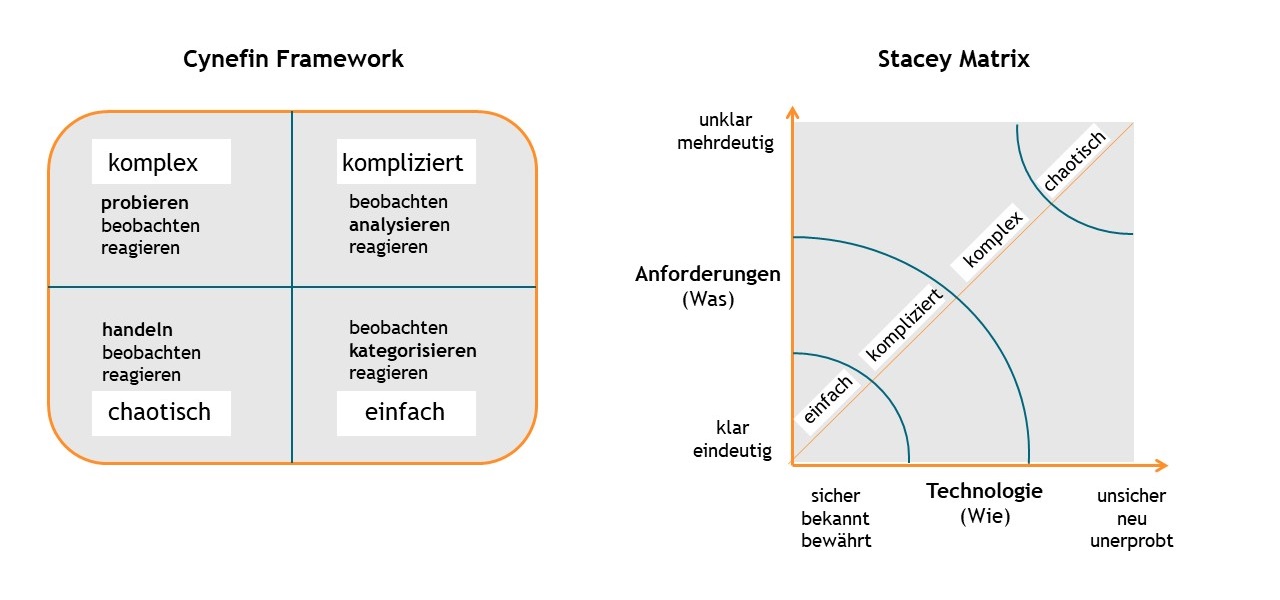
Simple situations
Simple situations are characterized by a simple cause-and-effect principle. The solution is known and only needs to be selected and implemented correctly. No creativity is required here, on the contrary: "best practices" and "standard operating procedures" are in the foreground. The action plan is: "Observe problem - categorize - react".
Complicated situations
When the connection between cause and effect is no longer immediately recognizable, we speak of complicated situations. However, the connection can be determined through precise analysis or expert knowledge. The overall problem is broken down into sub-problems and analyzed in order to assign suitable partial solutions. Based on this, an overall solution is found. The recommended course of action here is "observe - analyze - react".
Complex situations
In complex situations, a forward-looking cause-and-effect analysis is no longer possible. Dynamics are now at play. The resulting impulses and feedback effects prevent the predictability of system behavior. Cause-effect relationships do exist. However, these can only be perceived in retrospect or with hindsight. This means that there are no clearly correct solutions that can be planned in advance. Instead, you focus on small iterative steps in which you experiment again and again and look for patterns. The next step is chosen based on the experience gained in this way. The approach here is "try - observe - react".
Chaotic situations
In chaotic situations, the connection between cause and effect is not recognizable. Severe crises or disasters often fall into this category. People fall back on simple rule systems and act quickly and instinctively, concentrating on what matters most. The recommended pattern of action is therefore "act - observe - react".
Quo vadis Engineering
An example from the plant engineering division of Siemens AG (Vollmar et al. 2017) shows that this scheme is also used in industry to classify problems. The Cynefin framework is used to structure the Group's various engineering tasks in such a way that insights can be gained into the approach and also the future direction of the product portfolio. A distinction is made between the Cynefin categories "simple", "complicated", "complex" and "chaotic" and four approaches to finding solutions: "Easy Engineering", "Perfect Engineering", "Pioneer Engineering" and "Crisis Engineering".
Easy Engineering
The tasks of "Easy Engineering" are characterized by the fact that the systems used are closed and known. Standardized systems are configured and adapted at the interfaces for the implementation of customer-specific solutions. No in-depth knowledge of the technology of the individual systems is required. The partners involved implement the overall system using their knowledge and experience of the performance of the system modules under specific conditions on site.
Perfect Engineering
Perfect engineering" solutions are also based on familiar technologies. However, the core of these technologies must also be further developed for the customer in order to achieve a "perfect" system design. This requires engineering knowledge of the technology itself. The recommended approach is plan-oriented and is based on the reference model of systems engineering (V-model).
Pioneer Engineering
In "Pioneer Engineering", you are moving into new territory with a high degree of innovation. The scope of the project, the technology used or even the contractual framework conditions can be new. If there is no longer any experience, the uncertainty increases and with it the complexity. Accordingly, an agile approach is recommended for finding solutions in order to be able to react quickly to any problems that arise.
Crisis Engineering
Crisis engineering is required when a crisis situation arises in a project with a high level of uncertainty, complexity and dynamics. Special skills and techniques are required to recognize, grasp and understand the threat at an early stage.
Complicated versus complex
Both the Cynefin model and the Stacey matrix are primarily concerned with the distinction between complicated and complex. The extreme values "simple" and "chaotic" are often seen as extremes that are more or less taken into account. The Stacey matrix shows for the first time a linear functional relationship between the categories from "simple" to "chaotic" between the what and the how. The demarcation of the individual categories from "simple" to "complicated" and "complex" to "chaotic" varies depending on the author, but is entered clearly in the matrix.
However, we are convinced that a sharp distinction between complicated and complex cannot be made. For this reason, we only use the two criteria of complexity and intricacy in our model, which we assign to the efficiency-oriented and innovation-oriented strategy for decision-making. The extreme values "simple" and "chaotic" are regarded as special cases which, as equivalent terms, mean nothing other than
- 100 percent complexity = "simple" (= black)
- 100 percent complexity = "chaotic" (= white).
As described above, all tasks that actually occur between these two extreme values can therefore be described as "gray", with a proportion of complexity and a corresponding proportion of complexity. This means that every real task that does not correspond to the extremes (100 percent) always contains both proportions.
Spoilt for choice
How can the decision model shown above be used in project management? In practice, an optimum of efficiency, quality and risk minimization is usually sought in order to achieve a desired goal: the best compromise between these criteria, so to speak. To achieve this, it is advantageous to choose the right methods for completing tasks or solving problems.
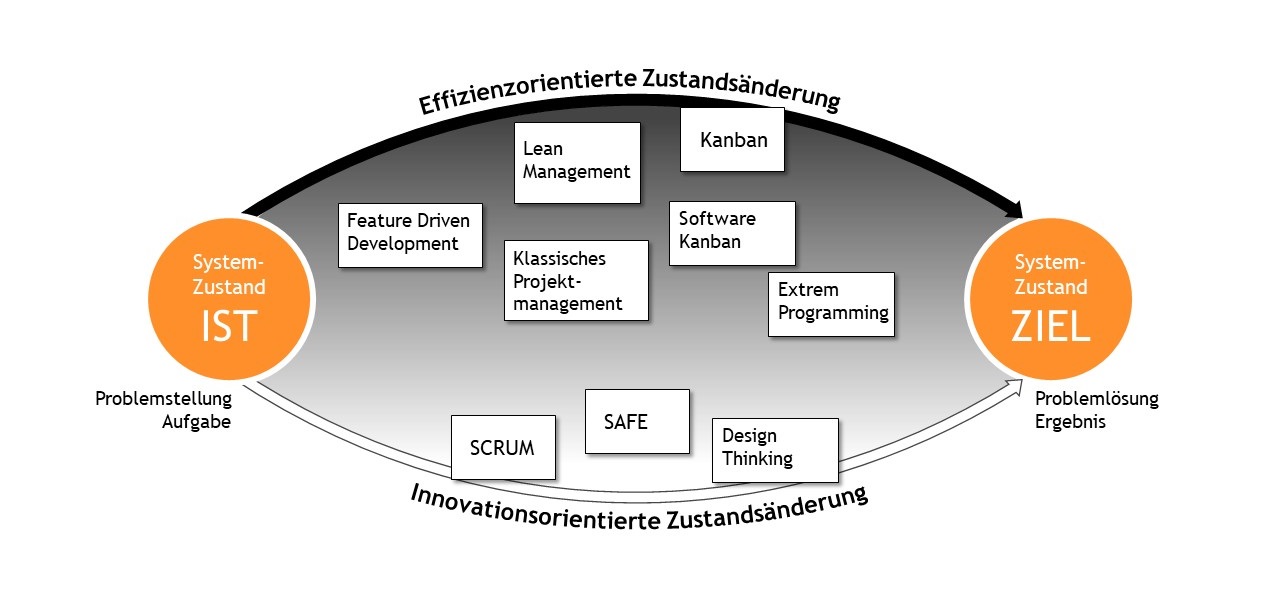
In order to differentiate between the methods, we classify all methods according to their specific methodological value, the efficiency-oriented and innovation-oriented objectives and effects on which the methods are based. For example, we see SCRUM (strictly according to the SCRUM Guide) and Design Thinking very close to 100 percent innovation-oriented, while we see KANBAN, for example, as well as most lean management approaches, as being close to 100 percent efficiency-oriented. We see traditional project management and extreme programming as being more balanced between these two extremes, with a preponderance on the innovation-oriented side in extreme programming and a slight preponderance on the efficiency-oriented side in traditional project management. Project ManagementSoftware-KANBAN and Feature Driven Development are moving even more in the direction of efficiency.
Of course, this list is not exhaustive. Hybrid approaches that combine at least two methods can also be categorized in this way. The SAFe approach for example, is very close to the innovation-oriented part because of its consistent SCRUM basis, but not as close as SCRUM.
Ultimately, the aim is to leverage the specific strengths of the methods and minimize their specific weaknesses. To achieve this, it is necessary to find and combine the appropriate methods in each case. If the specific objective is also evaluated according to its relationship between efficiency and innovation orientation, the approach presented here provides an effective means of selecting and combining the right methods.
The selected methods also require specific organizational forms. The approach presented here is therefore also suitable for supporting the development of new organizational forms. We are convinced that, due to the infinite diversity of the 'gray' world between the two strategies, many individual hybrid approaches will continue to develop. The seminar developed together with the VDI Knowledge Forum "Managing agility correctly - opportunities and limitations of agile methods in project management" deepens the necessary knowledge to enable project managers to make the right decision when choosing a suitable project management approach.
The dual organization
In organizational research, an approach has existed since the mid-1970s that has become known as organizational ambidexterity or "dual organization" (Smith et al. 2017). This term refers to the ability of a company to be active in both efficiency and innovation mode at the same time. The activities in efficiency mode are referred to as "exploitation". Activities in innovation mode, on the other hand, are referred to as "exploration".
Typical features for the efficiency mode are
- stable structures,
- Consistency
- Process orientation
- Power measurement
- conventional reporting.
In this mode, the aim is to make a steady state even more efficient through continuous optimization.
In the innovation mode, on the other hand, the organization pursues the goal of being able to react flexibly to changing requirements. This includes features such as
- loose structures
- Self-organized teams
- Flexible processes
- constant trial and error and learning.
The dual perspective does not favor one mode or the other, but recognizes both as necessary skills in order to remain viable in the long term.
Since 2017, TCI has been involved in the international research project "Being Lean and Seen: Meeting the Challenges of Delivering Projects Successfully in the 21st Century" project. This project deals with the question of how companies manage to put the dual organization into practice and how project management must be designed for this. The decision model shown in Figure 2 serves as the basis for categorizing, describing and evaluating the respective business areas and the approaches based on them. The initial results will be published in mid-2019.
Conclusion
With the spread of agile approaches outside the software industry, the "toolbox" of possible action strategies in companies has been expanded to include extremely important approaches. Despite the VUCA situation, agile methods make it possible to consistently pursue a given goal. According to our model, agile methods are primarily assigned to innovation-oriented solution paths. We assume that the methods of "operational excellence", which are located on the more efficiency-oriented solution paths, are equally important. Because being first is not enough in the long run. In the end, time works for the best.
Further information
If you would like to delve deeper into this path between the extremes of efficiency and innovation, we recommend the following three works, which have also been incorporated into this article:
- Smith, A. C. T.; Sutherland, F; Gilbert, D. H. (2017). Reinventing Innovation - Designing the Dual Organization. Palgrave Macmillan 2017.
- Snowden, D. J.; Boone, M. E. (2007). A Leader's Framework for Decision Making. Harvard Business Review, 11/2007, 69-76.
- Vollmar, J.; Gepp M.; Palm H.; Calà A. (2017). Engineering framework for the future - Cynefin for Engineers. IEEE International Symposium on Systems Engineering 2017, Vienna October 11-13.
(Authors: Harald Kretschmer and Dr. Helmut Schäfer)
(Cover image: © yudhistirama | stock.adobe.com)

